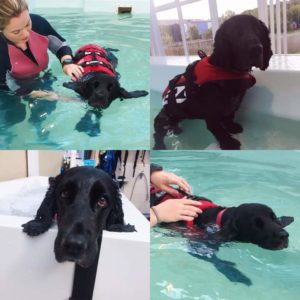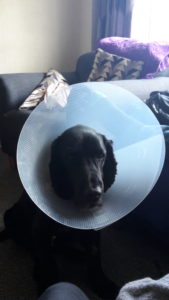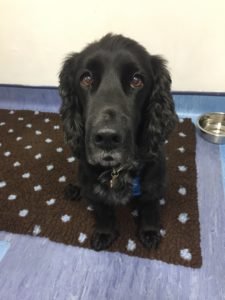Brave Pet of the Month….Lemmy!
 Our brave pet this month is Lemmy, a loyal and loving Cocker Spaniel who is owned by one of our receptionists, Jane. Lemmy began suffering with lameness in November 2016. Jane had noticed he was starting to slow down on his walks, seemed lame in the evening and occasionally hopped on his right forelimb.
Our brave pet this month is Lemmy, a loyal and loving Cocker Spaniel who is owned by one of our receptionists, Jane. Lemmy began suffering with lameness in November 2016. Jane had noticed he was starting to slow down on his walks, seemed lame in the evening and occasionally hopped on his right forelimb.
Lemmy was examined and found to be painful in both of his elbows; the right was noted to be worse which correlated with his signs at home. At Lemmy’s age and with the presentation of signs it was likely Lemmy was starting to show signs of osteoarthritis (OA). This can be secondary to an underlying conformational or developmental issue, for example, elbow dysplasia or can be due to normal wear and tear, often described as degenerative joint disease. He was started on non-steroidal-anti-inflammatories (NSAIDs) which are the preferred drug in the management of OA.
 There was a noticeable improvement in his demeanour and level of activity on this medication but over the next few months the lameness in his right forelimb kept recurring and this was usually associated with off lead exercise. Given that OA is a progressive condition it might have just been Lemmy needed more pain relief and management however without imaging the joints we could not rule out there wasn’t a more significant underlying cause or something that could be done surgically. The preferred imaging modality for elbows is CT therefore we referred him to Liverpool Small Animal Teaching Hospital for further investigations
There was a noticeable improvement in his demeanour and level of activity on this medication but over the next few months the lameness in his right forelimb kept recurring and this was usually associated with off lead exercise. Given that OA is a progressive condition it might have just been Lemmy needed more pain relief and management however without imaging the joints we could not rule out there wasn’t a more significant underlying cause or something that could be done surgically. The preferred imaging modality for elbows is CT therefore we referred him to Liverpool Small Animal Teaching Hospital for further investigations
Lemmy’s CT scan showed he had medial coronoid disease in both of his elbows with severe secondary osteoarthritis. Medial Coronoid disease is a a form of abnormal joint development and is encompassed in the term ‘elbow dysplasia’.
There was the option to remove the abnormal cartilage via a minimally invasive key-hole technique. However, due to the level of osteoarthritis already in the joint it was very unlikely that removal of this cartilage would automatically fix Lemmy’s condition. We would still need to manage the secondary OA. Option two therefore was to continue with supportive medical management but at least doing so with the confidence that we are doing the right thing.
The medical management of OA is multi-modal and Jane has worked really hard with Lemmy to encompass them all in his care.
- Pain relief. NSAID’s are the starting drug of choice but as OA progresses it is inevitable that additional pain relief is needed and we have a number of different options for dogs.
- Exercise moderation. Strict rest can be initially needed to allow inflammation in the joint to settle. Gradual re-introduction of exercise is the next step and then moderating our pets level and frequency of activity ongoing. Unfortunately, our pets lack any self-preservation and many animals will be able to exercise and do so willingly even though underlying this they are painful. It is therefore up to us to manage what they do. Little and often is better than long walks and limiting high impact exercise like chasing a ball.

- Weight management. Keeping your pet lean will reduce the load on your pets joints. Strict feeding and even special diets can be employed.
- Joint supplements. A combination of omega 3 and 6 fatty acids, Glucosamine and Chondroitin, green lipped mussel extract and more can help provide important components your pet’s joint needs to repair itself.
- Hydrotherapy/Physiotherapy. Hydrotherapy can be helpful to encourage weight loss in a low impact way. Both modalities act to improve the range of motion in a joint and to maintain muscle mass.
Despite all of the above, Lemmy was still having good days and bad days. In some dogs an injection of steroid directly into the joint space can help reduce inflammation therefore inflammation associated pain . We have had very successful experiences with this, however it is not always effective for all patients and it is not always long lasting.
 Stem cell therapy has now become available within veterinary medicine. Stem cells are naive cells which develop according to the environment they are placed in. This can be employed in the management of OA by injecting stem cells into a joint to help repair and replace damaged tissues. Fatty tissue and blood has to be collected from the individual in order to harvest and reproduce the stem cells and this requires a general anaesthetic. Once the injections are ready they are then injected into the joint space whilst under sedation.
Stem cell therapy has now become available within veterinary medicine. Stem cells are naive cells which develop according to the environment they are placed in. This can be employed in the management of OA by injecting stem cells into a joint to help repair and replace damaged tissues. Fatty tissue and blood has to be collected from the individual in order to harvest and reproduce the stem cells and this requires a general anaesthetic. Once the injections are ready they are then injected into the joint space whilst under sedation.
Lemmy had his stem cell therapy injection into his right elbow in October . Four weeks down the line he was doing remarkably well. He was still on some pain relief which is to be expected but he was already coping with far more exercise than he had in a long time. With such a promising response Lemmy is now having a stem cell therapy injection in his left elbow in the new year!
Lemmy is such a well mannered and beautiful boy, we are so pleased he is feeling comfier and able to enjoy the things he loves to do. All thanks to his wonderful owner Jane who’s dedication and time has paid off.

